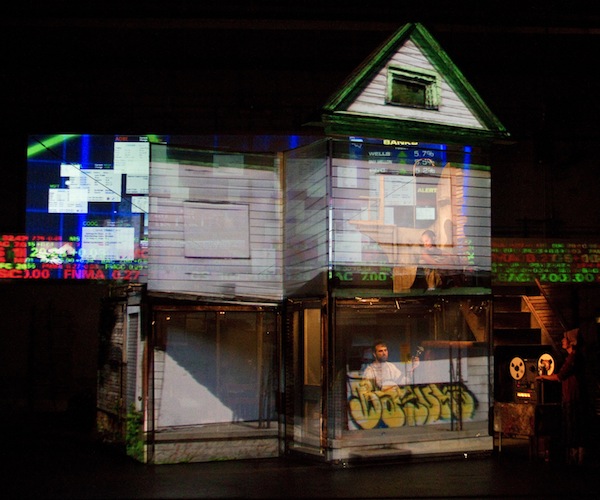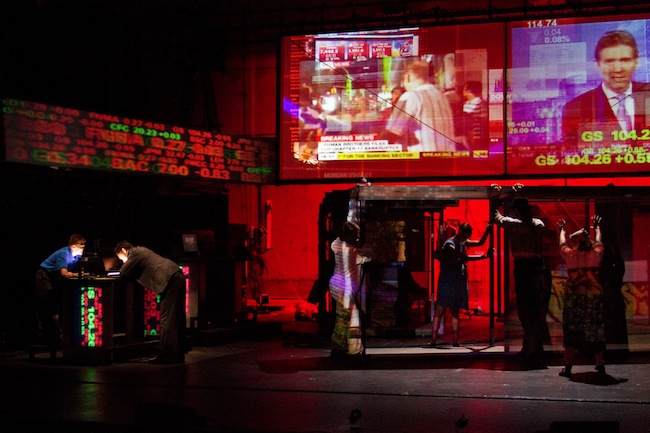Theater Review: A Pitch Black “House/Divided”
“House/Divided” – a mélange of dazzling videography, startling and inventive lighting/props/stage craft, and spoken snippets of John Steinbeck’s quasi-Biblical prose – does not add anything new to our understanding of the current national malaise.
House/Divided, written by James Gibbs and Moe Angelos. Inspired by The Grapes of Wrath, a production written and staged by The Builders Association. Directed by Marianne Weems. At ArtsEmerson, Majestic Cutler Theatre, Boston, through February 2.
By Robert Israel
I attended House/Divided a few days after listening to President Obama deliver his State of the Union address to a fractious and do-nothing Congress. Another American President – Abraham Lincoln – argued that “a house divided against itself cannot stand,” and President Obama faces the same struggle. This play, meant to resonate title with the former as well as current political stalemate, does a compelling job showing us how awful things are, without giving us a shred of hope that the republic can ever be repaired.
House/Divided – a mélange of dazzling videography, startling and inventive lighting/props/stage craft, and spoken snippets of John Steinbeck’s quasi-Biblical prose – does not add anything new to our understanding of the current national malaise. What this sprawling, uneven, bold yet ultimately unsatisfying effort does accomplish is to tell us – and only to dramatize occasionally for us — what we already know. Today, as in days of yore in these United States, the people are struggling to survive the obstacles posted by a system fueled by greed and mendacity.
A cast of six players who take on numerous roles labor mightily to communicate what turns out to be a superficial comparison/contrast. Steinbeck’s populist narrative details how the Okies escaped the ruins of the Dust Bowl only to find their hopes dashed in the “sugar bowl” (to use Woody Guthrie’s words) that is California. This classic yarn of lower class struggle and dispossession is set against supersonic bankruptcy in contemporary America, where multi-billion profits were extracted from the low and middle classes via a battery of real estate and banking swindles. It’s not a new story. Foreclosure, financial ruin, homelessness, and greed are as American as cherry pie. The Builders Association wants us to see how the chicanery today is rooted in a poisoned past, and that our embrace of capitalism will lead to the invention of further divisions and scams. It’s not only polemical. It is too much six o’clock news. The hyped-up effect, rather than illuminating, becomes dulling.
The kinetic set – conceived by John Cleater and Neal Wilkinson – is made up of moveable scrims that serve as video screens on which are beamed glimpses back to the ’30s as well as contemporary scenes. Still, for all of the sophisticated techno activity, the staging ends up drowning in too much razzle-dazzle – our eyes and ears are wearied by the bells and whistles: computerized ticker-tape numbers circle above the performers in constant green and yellows; a series of video interviews include a repo-man who muses on finding “stuff left behind” in abandoned homes he has been assigned to liquidate; newspeak by newscasters announce (again and again) the demise of yet another financial giant on Wall Street, done in by greed-flavored Kool-aid. It’s too much of an assault on the senses, purposefully meant to overwhelm. House/Divided doesn’t give viewers an opportunity to think on the ties that bind us to our troubled past or to speculate on our uncertain future.
Technology can be used to enhance contemporary theater productions, as it was during an ArtsEmerson presentation of of Robert Lepage’s The Andersen Project last season. The show drew on a story from the 19th century and then used it to explore how an actor vagabonding his way through Paris in the 21st century was vividly (and ironically) connected to a past, present and future. Lepage orchestrated his multi-media so that it hooked the audience into the drama’s rhythms and pulsations, enhanced the spoken word, and illuminated the acting. While I marveled at The Builders Association’s use of computer razzle dazzle in House/Divided, I also felt it was specifically designed to leave little or no room for dramatic nuance, for political subtlety, for serious reflection. Sitting through the production felt as if you were walking through New York City’s Times Square as evening comes on, the huge JumboTrons seeming to pulse brighter and brighter, turning night into day. House/Divided, with all its technical wizardry, needs to learn from Lepage’s approach — restraint can be a virtue.
It would be charitable to note that the script calls for pruning, but it would be honest to say it needs radical surgery. What’s missing is a sense that the people it portrays have more than despair to look forward to. Wretched defeat is graphically dramatized in scene after scene. While Steinbeck’s descriptions of hardscrabble canneries, cruel bosses, starvation, worker exploitation and dust bowl catastrophes detailed the bottom line, he also left us with a sense that we, the people, would endure. Nowhere in The Builders Association production is there recognition of the enduring human spirit that Steinbeck insisted remained, despite the debacle. House/Divided holds a mirror up to our divided nation. But that reflection is monomaniacally dark, a glib defeatism that is the flip side of sentimentality.
Robert Israel writes about theater, travel and the arts, and is a member of Independent Reviewers of New England (IRNE). He can be reached at risrael_97@yahoo.com


